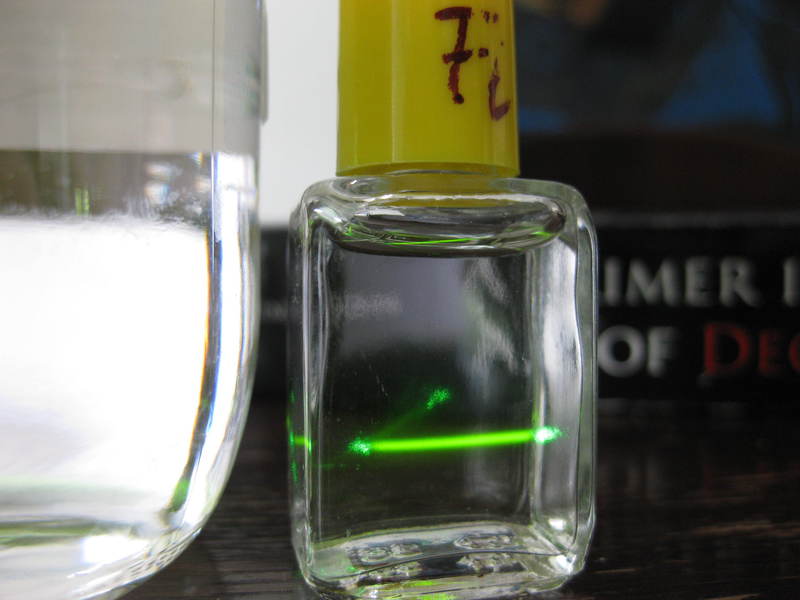I wanted to measure fluophore response to excitation with the supplied laser diode pen. The fluophore is disolved at an uknown concentration in destilled water and has optimum excitation with green light and responds also quite well with blue light. Fluorescence is orange/red and easily visible with the naked eye as well defined orange beam traversing the liquid. However due to the low light emission it is not picked up by the spectrometer. Possibly due to alignment problems with the slit of the spectrometer entrance. What diffuse light source could be suggested within the blue/green range to excite the fluophore and how to better the sensitivity of the web cam?
Background story
detection of fluorescent aptamer sensors in the field ("point of care") using inexpensive consumer goods technology like smart phones and public labs open software. Thanks Henry
Hi Jeffrey thanks for the response and apologies for my late reply.. I use as a fluorophor Atto 595 of unknown concentration but possibly in the range of 100 - 10 nmol/l. At the time it was used as an optical/fluorescence standard against td-tomato expressed in the cells of a genetically engineereda fluorescent biosensor. My measuring set up is the spectrometer in the card box orientated either with parallel or perpendicular orientation of the collimator slit towards the laser beam. Pics of my set up.
the green fluorescence in the left bottle is from Uranium glass splinters
The laser beam shows orange fluorescence to the naked eye transversing the liquid but the camera seems to pick up mostly the green from the laser reflected. The last pic is with blue excitation from the blue laser pen supplied with the kit. Henry
two more pics demonstrating that there is orange/red fluorescence from the fluorphore:
the last one taken with a red photographic filter in front of the lens (HOYA R=4/O-58). It totally blocks the geen laser light used for excitation







Hi, Henry - what is your fluophore?
Did you purchase the alpha oil testing kit with the blue/uv laser pen?
I've been able to line up the desktop spectrometer and get a decent reading -- can you upload an image of your setup so we can see how you're scanning? And how bright the fluorescence is? You can just click "Edit" for this post and drag an image into the "main image" field to the right, or actually just into the text area for the post itself. Multiple photos would be really helpful too!
Is this a question? Click here to post it to the Questions page.
Reply to this comment...
Log in to comment
Wow the photos are amazing. Was there a reason you mostly used the green? A blue laser will excite a broader range of colors, since light can only excite colors at wavelengths longer than itself.
Your feedback on the alignment of the slit with the laser is really good. We're thinking of swapping in UV LEDs instead of a laser... what do you think?
Is this a question? Click here to post it to the Questions page.
Reply to this comment...
Log in to comment
Also can you share any of the spectra you did get? Links? Thanks!
Is this a question? Click here to post it to the Questions page.
Reply to this comment...
Log in to comment
@stevie did you see this note now that Henry's added images? Pretty neat, and perhaps one of the only posts I've seen of the oil testing kit in the wild.
Is this a question? Click here to post it to the Questions page.
Reply to this comment...
Log in to comment
Hi Jeffrey, "Was there a reason you mostly used the green? A blue laser will excite a broader range of colors, since light can only excite colors at wavelengths longer than itself."
Green was used as an old habit and because the fluorescent protein tdTomato has its absorption maximum in the green. tdTomoato was used as the reporter gene in a soill bacterium which is currently researched as a biosensor for trace explosives to detect landmines from the air. Currently an EU research project "D-Box" is acting as a follow up of that technology concept. My idea is to use fluorescent aptamer sensors and consumer electronics/smartphones/WiFi/NFC to build the electronic "mine detection dog" wihich unlike the real dog has stand off capability in landmine detection and would be much more affordable, albeit less fun than the real dog.
"swapping in UV LEDs instead of a laser" sounds good to me, I probably have to flood the cuvette with excitation light and use filters to get fluorescence detectable by the web cam. Other possibilty would be lenses? more laser? more sensitive camera.
"Also can you share any of the spectra you did get? Links? Thanks!" https://spectralworkbench.org/tag/laser%20pen%20405%20nm https://spectralworkbench.org/analyze/spectrum/28509 https://spectralworkbench.org/tag/blue%20laser%20pen%20%20fluorescence%20in%20dog%20toy the last link shows green fluorescence from a fluorescent ball excited with the blue laser pen. I was never able to detect the orange/red fluorescence from Atto - either because of alignment problems with the collimator slit or because the fluorescence disappeared within the background noise. Also I need to adjust the focus of my web cam by moving it around inside the housing. When assembling the spectrometer I just guessed the best distance between camera and slit. Thanks Henry
Is this a question? Click here to post it to the Questions page.
Reply to this comment...
Log in to comment
Thanks for the info... I was looking for it myself.. And big up for your photos, sir..
Reply to this comment...
Log in to comment